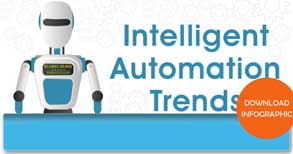Introducing the First Article in our Straight Through Processing (STP) Series
The difference between attended and unattended automation with document-oriented processes and where each succeeds or fails are important to explore. Since all of the feverish excitement around the adoption of machine learning, something funny has occurred; there is an expectation that we can replace humans with robots.
Is a complete replacement always a realistic goal and if not, what would be realistic? Wholesale replacement has already occurred in some areas like auto assembly and textiles. In more complex knowledge worker-oriented processes, only the simplest of tasks has removed the human quotient.
Desktop Automation Drives Expectations
One of the solution areas that is driving expectations the most, in terms of business processes, is robotic process automation or RPA. RPA emerged from the tried-and-true use of scripting and macros to automate simple and rote tasks such as moving data from one application GUI to another. This is most commonly referred to as desktop automation.
RPA excels at these types of automated tasks because it offers an easy way to “record” a user’s actions and play them back repeatedly with high throughput. The result is binary: either the task is completed successfully as a whole or it is not. This type of automation is what is known as unattended automation where the tasks don’t require input from a person, or only in rare situations. Organizations enthusiastically adopted RPA for all of their simple processes for obvious reasons: it reduces workload and allows staff to either be reduced or reallocated.
Unfortunately, only so many processes are simple and routine enough to support unattended automation via any type of solution. This is where expectations currently do not match the capability of solutions. RPA and business process automation vendors have started to talk of artificial intelligence using words like “cognitive” to convey the notion. Let’s take, for example, a process that involves more complex parsing of information: the information contained within documents.
Where the Standard View of Unattended Automation Fails
A mortgage lender has a lot of processes that involve documents. The origination process is arguably one of the most document-intensive processes that exists; there can be a few hundred to over a thousand different documents involved from the initiation of the process to the funding and completion of a loan. Can this complex process be automated to the extent that humans are not required? In other words, is such a process a candidate for unattended automation?
If we are defining unattended using principles of RPA where a task is either completely executed correctly or it is not, then the answer is decidedly “no.” This is because document-based data is complex. There are often many different data elements on a single page leaving a significant potential for error. Take, for instance, HUD 1008 form otherwise known as the “Uniform Underwriting and Transmittal Summary.” While relatively simple, this form can have over 40 different data fields to locate and extract.
The probability that any system can accurately locate all of the fields and extract them correctly is very low. If the document is more complex, such as an appraisal or an unstructured document where there are no easy ways to locate data, then the likelihood of an error on a single page rises dramatically. So using the “RPA-inspired” definition, even the most advanced machine learning system would most likely provide less than 5% unattended automation.
Document Classification and Unattended Automation
So what about document classification? Document classification is a binary answer of a document type. It either completes successfully or it does not. In a simple document classification task, single documents are submitted as individual files, and the only task involved is to identify them. Here high levels of unattended automation using the RPA definition can be achieved. In most cases, document classification is more complex due to cases where many documents arrive within a single PDF file requiring not only document classification, but document separation.
A document might be classified correctly but erroneously include a page from another document. The result is that a large loan file consisting of several hundred documents is most likely to contain multiple errors requiring human intervention. Even if humans are involved in these tasks, we often see errors between 2% and 9% that significantly impact the ability to have high degrees of page-level automation.
This page-based approach is actually how most advanced capture systems are configured – to deliver document and/or page-level results that are reviewed completely by human staff. This process is what is typically referred to as attended automation or humans in the loop. The best case scenario using this approach is that the staff are simply pressing the ENTER key a lot if the answers are correct. While this process is typically more efficient than performing data entry, it is hardly the highest level of automation that can be achieved. We should be able to completely eliminate a lot of those presses of the ENTER key.
A Different Way of Thinking About Unattended
Can true unattended automation really be achieved with complex document-oriented processes? The answer is “yes,” but it requires a different type of thinking. Instead of thinking about information within documents as a page-level construct, consider the data as the data, irrespective of the page on which it exists. Instead of thinking about a HUD 1008 as a page of data, consider each data element as an entity in and of itself, just like you might think about a cell within a record of a database as a single element.
Instead of visualizing a group of documents and pages with data, consider the loan packet itself as a complete database record of a loan consisting of several hundred or thousand data elements. Is it possible to achieve high-levels of unattended automation at the data element level? The answer is yes, often at rates of 80% and higher.
This is because advanced document automation, which is optimized, can divide document tasks at that individual data element level into two groups. There are those that are accurate and therefore, can be immediately used by other systems and those that need review by a person. Each data element can essentially have a pass/fail just like the simple tasks normally involved with RPA. Document or page-level decisions are not relevant. The key is to consider each individual task.
Taking a New Approach
The reality is that complex processes with many potential areas of failure, especially those that involve document-based information, are more likely to be approached as attended automation unless we can break free of the concept of page-based mentality, and separate the data we need from the modality in which the data happens to be presented.
At Parascript, we practically invented the concept of data-element level automation to achieve high-levels of process efficiency and cost savings.

For the latest trends in intelligent document automation, check out this infographic, “Intelligent Automation Trends: How the Digital Workforce Takes Advantage of Document Automation Solutions,” based on the recent AIIM Survey of 100 leaders in capture.




